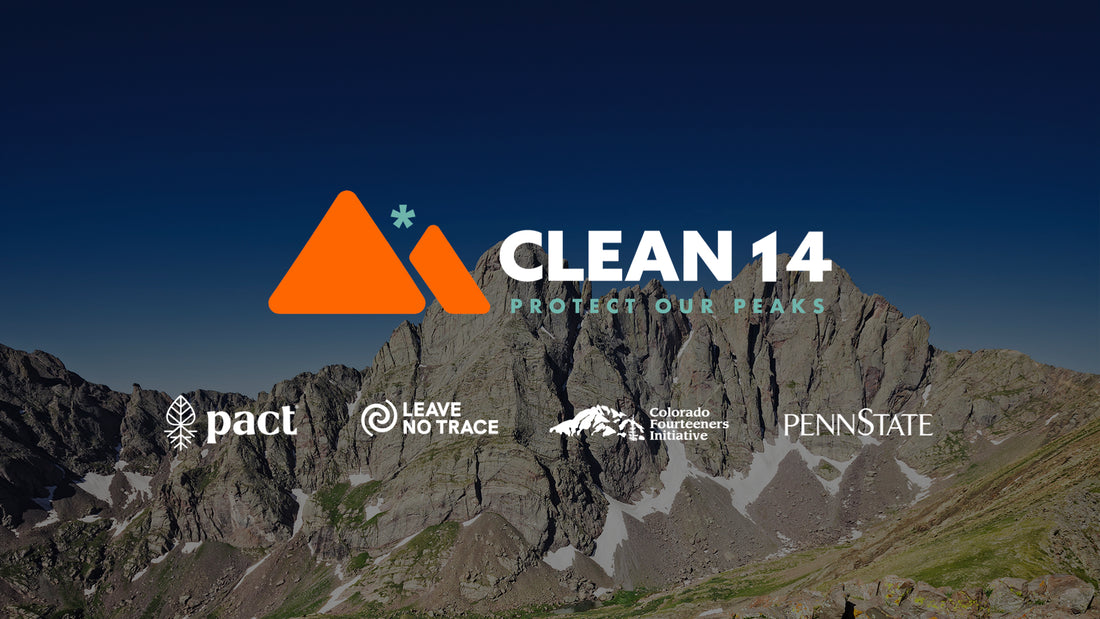
"Clean 14" Is Changing How We Think About Poop In The Outdoors
Share
This past July, we led a research study and pilot program aimed at studying people’s pooping behaviors on Colorado’s 14,000 foot peaks. Also known as 14ers. Fun stuff. These 14ers attract hundreds of thousands of hikers, many of them out-of-state visitors, in a span of about 10 weeks during peak summer.
14ers are unique in that hikers are strongly encouraged to pack out their poop above treeline due to the high usage and fragile alpine ecosystems. However, people's lack of familiarity and experience with this practice makes mis-handled human waste a significant issue for 14ers across the state. This is just a part of our growing issues with human waste on public lands.
For the study, we partnered with The Colorado Fourteeners Initiative, Leave No Trace and researchers from Penn State University's Department of Recreation, Park & Tourism Management.
The goal of the pilot program was to understand current attitudes and behaviors around packing out poop in the outdoors, factors that persuade hikers to pack out; and to test a first-of-its-kind pack out kit kiosk and disposal station. Our hope is to help land managers and trail organizations design and implement better, more cost-effective systems for waste management in the outdoors.

To study this, we installed a distribution and disposal kiosk at the North Mount Elbert trailhead with free Pack Out Kits and a trash bin to dispose of the bags. Mount Elbert is the highest peak in Colorado, but not necessarily the most highly-trafficked, so we expected it would serve as a good representation for the “average 14er”. Shari Edelson, a graduate researcher from PSU was stationed at the trailhead for three weeks surveying users as they completed their hike.
We obtained a statistically significant sample size of 4210 respondents and a response rate of 79% giving us a high degree of confidence that we surveyed a representative sample of hikers.
So, what did we learn!?
Takeaway #1: People Aren’t That Opposed to Packing Out Their Poop
Given the problems with poop throughout Colorado and other high use areas, our assumptions are that the general public is strongly opposed to packing out their poop. But, that’s not really the case. Although, the majority have heard of packing out or “wag bags”, most haven’t tried them and only 8% say they wouldn’t pack out. So, you're telling us there’s a chance!?

Takeaway #2: Lots of People Are Pooping, But Not In Vault Toilets
There’s an estimated 15,000 hikers on Mt. Elbert per year. Our research showed that 11% of people pooped either at the trailhead using the vault toilet or somewhere during their hike. 30% pooped in the vault toilet. The other 70% pooped somewhere on the mountain. So, we can estimate that 1,650 people poop at/on Mt. Elbert and 1,139 of those people pooped in the backcountry on their hike using a mix of methods. This is a surprisingly high number of people pooping on the mountain. Given the significant costs of building, pumping and cleaning vault toilets it suggests that strategies beyond toilets are necessary for addressing issues with human waste.

Takeaway #3: If You Build It, They Will Use It
30% of people that we surveyed packed out their poop using a pack out kit. All but one of those individuals used one of the free pack out kits we provided. That one person had brought their own. To give this some context. 30% pooped at the vault toilet, 30% packed out and the remaining 40% either buried their waste and TP or buried their waste and pack out their TP. A small percentage used some other method. Again, this usage rate was extremely encouraging given the number of people who might adopt this if it was used throughout an entire season. That’s potentially 495 poops that users might not have been adequately prepared for otherwise.

Takeaway #4: Trying A Pack Out Kit Impacts Future Behavior
This isn’t a one-time thing. When people take, learn about and (possibly) use a pack out kit, they report being significantly more likely to pack and use one in the future. Granted, there can be gaps in people’s intended future behavior and actual behavior. However, this still suggests that by providing a tool to people, we are having a cumulative effect of creating more skilled, and prepared outdoor enthusiasts over time.
Shifting Our Thinking
Regulations like converting dispersed camping to fee-based and requiring permits are rapidly increasing on public lands. Regulating people, while necessary, implicitly treat them as culprits that need to be managed. It puts them in positions of passivity. The type of approach we are studying here is built on the idea of empowerment, specifically that if you give people better tools, they’ll happily use them for the benefit of everyone.
It’s a major shift from our current thinking and policies in the outdoors, but one that over time has the ability to build more conscious, skilled outdoor enthusiasts, which will save land managers and trail organizations from striking costs currently going towards managed human waste in the outdoors…not to mention the environmental impacts.
We need approaches to stewardship problems in the outdoors that treat users as an integral part of the solution rather than passive recipients of information.
